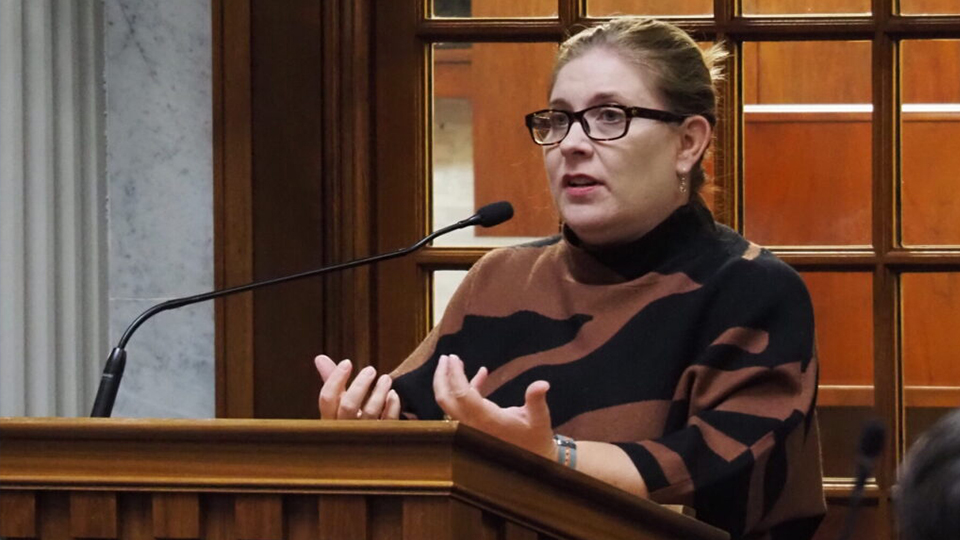Task force recommends boosting food assistance access
Subscriber Benefit
As a subscriber you can listen to articles at work, in the car, or while you work out. Subscribe Now
An interim land use task force set its sights on food insecurity on Tuesday — recommending legislation to make it easier for Hoosiers to qualify for food assistance, fund transportation or delivery for their groceries and more.
Lawmakers and laypeople representing a variety of industries additionally approved more than three-dozen recommendations on zoning, farmland preservation, infrastructure and redevelopment incentives, housing assistance, health care access and beyond.
Hoosiers going hungry
About one in every 10 Indiana residents didn’t have consistent access to enough food in 2021, according to the food bank network Feeding America — on par with the national average.
That’s more than 700,00 Hoosiers, according to Feeding Indiana’s Hungry Executive Director Emily Weikert Bryant. But only about 40% are income-eligible for the Supplemental Assistance Nutrition Program (SNAP) — and even fewer participate.
The federally funded, state-run SNAP is better known as food stamps.
Indiana University agricultural economist Shellye Suttles said many don’t apply because the process is “difficult and burdensome” compared to the benefits: $6.45 per person per day in September, according to the Indiana Family and Social Services Administration.
Applicants must make less than both a pre-tax and a post-tax income maximum, for example, and must have less than $5,000 in assets.
“In Indiana, for SNAP applicants, we exempt their house, the cars they use to get to work (and) lot of retirement funds … because you can’t touch them,” Weikert Bryant said. “But it’s essentially penalizing families who have a bank account with more than $5,000 in it — which is contrary to what we want. We want people to be able to have that cushion.”
And those who get into the program can struggle to access grocery stores and other vendors. SNAP can’t be used on transportation or delivery.
Task force member Paul Wyman — representing the real estate industry — noted that getting healthy food can be a “multi-hour process” for some Hoosiers without access to vehicles or efficient public transit.
“A lot of folks go to convenience stores and make their purchases there,” Wyman said. “Anybody on public transportation goes to the bus stop, (it) takes 45 minutes to get to the grocery store, you can only get a couple sacks to carry back on the bus, (and it’s) another 45 minutes home.”
The task force recommended that lawmakers streamline the SNAP application process, ditch the pre-tax and asset tests in favor of only a net-income requirement and look into funding transportation and delivery services for SNAP participants — among other suggestions.
Lengthy list of recommendations
It was the task force’s third and final meeting.
Sen. Blake Doriot, R-Goshen, said he and Co-Chair Rep. Kendall Culp, R-Rensselaer, labored to turn 50 pages of recommendations submitted by task force presenters into the report’s approved two pages.
The 13-member task force spent several hours Tuesday afternoon debating the recommendations, their phrasing and their potential consequences — but approved a revised report unanimously, 11-0.
“There was at least two other task forces this (interim) that could not pass a recommendation. They went away with nothing,” Culp remarked after the vote. “So, this is great.”
Much of the discussion was on solar and wind siting. Agricultural advocates have increasingly sounded alarms over the energy industry’s use of wide swaths of farmland for those developments.
“What we are asking is: plan with agriculture in mind. Farmland is not just open land waiting to be developed,” said Indiana Farm Bureau Public Policy Director Katrina Hall. “It is developed land. It’s conditioned, conserved, enriched … and irrigated. It’s a lifelong investment that passes from one generation to the other.”
The task force suggested that lawmakers create guidelines for siting such renewable energy projects — even directing them from farmland toward brownfields — and have the Department of Natural Resources look into best practices for constructing the projects on land previously used for surface coal mining.
The 40 recommendations also included county-level data collection on demographic and employment trends, boosting remediation and redevelopment of industry-contaminated brownfields, creating a statewide revolving loan fund for utility infrastructure, changing the state’s hospital assessment fee law and more.
Culp said recommendations with fiscal impacts wouldn’t be presented during the upcoming off-budget legislative session. But he’s hoping to maintain the group’s momentum that Statehouse leaders will approve another meeting ahead of the next budget session.
